#future of AI in automotive
Explore tagged Tumblr posts
Text
AI in Automotive Manufacturing 2025: Driving the Future of Smart Production

Introduction
The automotive industry is undergoing a paradigm shift, with artificial intelligence (AI) playing a crucial role in transforming manufacturing processes. AI in automotive manufacturing 2025 is set to revolutionize production efficiency, quality control, and supply chain optimization. From predictive maintenance to autonomous quality inspection, AI is enhancing every aspect of car production, making factories smarter and more efficient. In this article, we explore how AI is reshaping the automotive manufacturing landscape, its benefits, and the future it holds.
The Role of AI in Automotive Manufacturing
AI is bringing unprecedented efficiency and precision to car manufacturing by enabling automation, predictive analytics, and intelligent decision-making. Key areas where AI is making a significant impact include:
1. Smart Robotics & Automation
AI-driven robotic arms are streamlining manufacturing processes by executing tasks such as welding, painting, and assembly with extreme accuracy. Unlike traditional robots, AI-powered machines adapt to new tasks through machine learning algorithms, reducing downtime and improving productivity.
2. Predictive Maintenance
Predictive maintenance powered by AI helps automotive manufacturers prevent unexpected equipment failures. By analyzing data from IoT sensors, AI can predict machinery breakdowns and recommend timely maintenance, reducing downtime and costs.
3. AI-Powered Quality Control
Traditional quality control methods are being replaced by AI-driven vision inspection systems that detect even the smallest defects in car components. AI ensures consistency and precision, minimizing recalls and warranty claims.
4. Supply Chain Optimization
AI is optimizing the automotive supply chain by predicting demand, managing inventory, and identifying disruptions before they occur. This helps manufacturers maintain a steady production flow while reducing costs and improving efficiency.
5. Autonomous Vehicles in Manufacturing Plants
Automakers are integrating AI-powered autonomous vehicles within factories to transport materials, enhancing efficiency and reducing human intervention in logistics.
Benefits of AI in Automotive Manufacturing
The integration of AI in car manufacturing offers numerous advantages, including:
• Enhanced Efficiency: AI automates repetitive tasks, reducing manual labor and increasing production speed.
• Cost Savings: Predictive analytics minimize operational costs by preventing breakdowns and optimizing resource allocation.
• Improved Product Quality: AI-driven quality control ensures defect-free components, leading to higher customer satisfaction.
• Sustainability: AI helps reduce waste and energy consumption, making manufacturing more environmentally friendly.
• Workforce Safety: AI-powered robots take over hazardous tasks, improving workplace safety for employees.
Challenges in Implementing AI in Automotive Manufacturing
Despite its benefits, AI adoption in automotive manufacturing faces several challenges:
• High Initial Investment: Implementing AI-driven systems requires significant investment in technology and infrastructure.
• Skilled Workforce: Companies need trained professionals who can manage AI systems effectively.
• Data Privacy & Security: Protecting sensitive manufacturing data from cyber threats remains a critical concern.
• Integration Complexity: AI systems must be seamlessly integrated into existing manufacturing processes, requiring careful planning.
The Future of AI in Automotive Manufacturing
By 2025, AI is expected to become an integral part of every automotive production process. Key future trends include:
• Fully Automated Factories: AI will lead to the development of smart factories with minimal human intervention.
• AI-Driven Customization: Personalized car manufacturing will be possible, allowing customers to customize vehicle features in real time.
• Sustainable Manufacturing: AI will enhance sustainability by optimizing resource usage and reducing emissions.
• Collaboration Between AI & Humans: AI will complement human workers, enabling them to focus on high-value tasks while AI handles repetitive processes.
Conclusion
The AI in automotive manufacturing 2025 revolution is transforming the industry by improving efficiency, quality, and sustainability. As automakers embrace AI-driven technologies, they will unlock new opportunities for growth and innovation. While challenges exist, the benefits of AI far outweigh the hurdles, making it a game-changer for the future of car manufacturing.
#tagbin#writers on tumblr#artificial intelligence#technology#ai trends 2025#AI in automotive manufacturing 2025#AI in car production#artificial intelligence in auto industry#AI-driven vehicle manufacturing#smart factories in automotive#AI-powered car assembly#robotics in automobile production#future of AI in automotive#AI automation in car factories#machine learning in automotive industry
0 notes
Text
Standford University Dynamic Design Lab taught a DeLorean to drift on its own
2 notes
·
View notes
Text
ChatGPT in Cars: The Future Co-Pilot or Just Clippy on Wheels?
The car of the future won’t fly. It won’t run on hopes and dreams. But it will ask if you’re feeling stressed and whether you’d like it to play a chillwave playlist while it books your next oil change. Yep. ChatGPT—and its AI buddies—are making their way into your car. But whether this is a revolutionary driving companion or just the next annoying infotainment upgrade depends entirely on who’s…
#ai in cars#automotive future#automotive satire#automotive tech#chatgpt#gm infotainment#hoopty opinion#mercedes mbux#smart cars#vehicle AI
0 notes
Text
5 Applications of Augmented Reality in the Automotive Industry
Augmented reality (AR) is reshaping the automotive industry in ways that feel straight out of the future. From making car repairs faster and easier to transforming how we experience new vehicles, AR is becoming an essential tool. Imagine a technician using smart glasses to see step-by-step repair instructions overlaid on a car, or a new driver sitting in their car and learning about all its advanced features through interactive AR tutorials instead of flipping through a bulky manual. Showrooms are evolving too—AR lets customers visualize custom colors, trims, and features in real time, even when the showroom is closed. On the manufacturing side, AR overlays digital designs onto clay models, helping designers experiment and collaborate remotely, while assembly lines use it for quality control and training. Whether it’s simplifying car repairs, improving manufacturing, or making buying a car more exciting, AR is transforming every part of the automotive journey into something smarter, faster, and far more engaging.
0 notes
Text
The Top Concept Cars of 2024
In the ever-evolving world of automotive design and technology, 2024 has brought a plethora of groundbreaking innovations that have captured the imagination of car enthusiasts and industry experts alike. The top concept cars of 2024 are not just futuristic in design but also incorporate cutting-edge technology that redefines the driving experience. These concept cars offer a glimpse into the…
#2024#5G connectivity#advanced materials#advanced safety#Aerodynamics#AI#AR displays#Audi#Automotive#autonomous driving#biometric access#BMW#Clean Energy#Comfort#concept cars#connectivity#Eco-Friendly#efficiency#electric powertrain#electric vehicles#EVs#future cars#futuristic design#High-Performance#Hyundai#innovation#Lightweight#Luxury Cars#machine learning#Mercedes-Benz
0 notes
Text
Dive into the Future: Explore the Magic of Generative AI in Automotive Innovation!
From redefining design to predicting maintenance, join us on a journey through the revolution reshaping the roads!
1 note
·
View note
Text
New Mercedes Benz CLA Concept
The CLA Concept is a visually striking and technologically advanced technology that showcases Mercedes-Benz's vision for the future of electric mobility.
Design and Performance: You will notice the futuristic, aerodynamic design of the CLA Concept with a length of 4.74 meters and a width of 1.95 meters. It has an impressive WLTP range of over 466 miles (750 km) and charges from 0 to 250 miles in just 15 minutes.
Platform and Technology: Based on the Mercedes Modular Architecture (MMA) platform and supported by the MB.OS software system, CLA Concept offers Level 3 autonomous driving capabilities. It uses the innovative MBUX Hyperscreen, a triple display for an immersive user experience.
0 notes
Text
Driving Innovation: Exploring the Impact of AI on the Road to Smart Mobility
The integration of Artificial Intelligence (AI) with automotive technology is no longer just a concept from science fiction; it’s rapidly becoming a central part of how we envision the future of transportation. As cars become more than just a means to get from point A to point B, the role of AI in enhancing the driving experience and vehicle functionality has become increasingly important. This…

View On WordPress
#AI-Driven Car Features#Artificial Intelligence in Automotive#Automotive Industry Trends#Autonomous Vehicles Technology#Connectivity and IoT in Cars#Electric Vehicles and AI Integration#Future of Transportation#Innovations in Vehicle Navigation#Intelligent Traffic Management#Safety Enhancements through AI#Smart Mobility Solutions#Sustainable Automotive Innovations#User Experience in Smart Cars
0 notes
Text
Crafting Your Path: Embedded Systems Course with Placement at NeuAI Labs
Join NeuAI Labs for an embedded systems course with placement support. Gain real-world experience and kickstart your career
#embedded systems course#embedded systems course in pune#automotive embedded systems course in pune#embedded software training#automotive embedded internship#neuailabs#future of ai
0 notes
Text
MediaTek Partners With NVIDIA to Provide Full-Scale Product Roadmap to the Automotive Industry
Manila, Philippines – MediaTek today announced a partnership with NVIDIA to deliver a complete range of in-vehicle AI cabin solutions for the next generation of software-defined vehicles. The collaboration combines the strength of each company’s automotive portfolios to deliver the most compelling solutions for state-of-the-art connected cars. “NVIDIA is a world-renowned pioneer and industry…

View On WordPress
0 notes
Note
now I do agree with a lot of what you're saying. AI is a tool that can be used (even by traditional artists also, the same way many traditional artists use 3D tools to create backgrounds in perspective instead of drawing it own their own)
But what really bothers me is the environmental impact. We know everything we do online has impact on the environment, but AI elevates this to the next level. I'm not even talking about training and maintaining GenAI, which is already pretty devastating but not unlike other technologies we have, but about the end user being able to cause a pretty big negative impact.
There is also a huge inequality of distribution of that impact. Companies that might be interested in keeping their energy usage carbon free or sustainable in, say, parts of europe, will do no such thing in asia and south america. We end up with data centers that will strain freshwater resources in the global south so that AI artists can make art?
I understand your points but I still think that all things being considered, we shouldn't be focused on whether AI art is art or not but rather on it should be regulated and it's environmental risks addressed.
Actually, AI barely budges the needle on environmental waste. The vast majority of industrial water use is for farming and agriculture, followed by apparel, beverage, and automotive manufacturing. You would do far, far more good for the environment by going vegetarian than by giving up AI art, and even within the tech industry, I'm pretty sure things like chip manufacturing take significantly more water and energy than data centers do.
End users barely make an impact at all - a chatGPT prompt or an image generation uses significantly less energy than, say, an hour of playing a video game or watching Youtube.
You are correct that offshoring data centers and manufacturing to dodge environmental regulations is a problem! But it's already a huge problem in multiple manufacturing industries. That's not a hypothetical future problem, it's literally happening right now. But the same people up in arms about how bad AI is for the environment are suspiciously quiet when it comes to demanding that individuals stop eating meat, buying new phones or playing video games, even though they are orders of magnitude worse for the environment.
23 notes
·
View notes
Text
LUXURIOUS CARS TRANSPORTED BY SAN JOSE AUTO SHIPPING

Safely Transporting Luxurious Cars
Imagine a luxurious car sitting in a workshop. Its inside is pristine, with leather seats and shiny controls. Transporting it isn't just about speed; it’s about safety. A professional car carrier company with a fully insured car shipping options knows how to handle these cars without any damages. They use a modern equipment to secure the vehicle firmly. It's not just about getting from one place to another. It’s also about keeping every piece intact, from the dashboard to the tiniest knobs. These carriers are trained in how to load and unload high-end cars carefully. They plan routes that avoid rough roads and sharp turns. During the trip, the driver keeps the interior safe from dust and dirt. They often cover the car to protect it from weather. Clear communication between the car owner and carrier is key.
The goal is simple: deliver the car in perfect condition. This process requires attention to detail and years of shipping experience. Car owners trust these carriers because they know their luxury car is in good hands. Transporting a luxurious car with cool interiors is about more than just shipping a vehicle. It’s about protecting a valuable investment from start to finish.
CARS WITH STYLISH DESIGN THAT SAFELY TRANSPORTED
Finding a reliable auto transporting guide on how to choose a trustworthy shipper and what to look for is necessary before transporting your luxury car, to make sure you are equipped with the right knowledge before committing to the right car shipping service to handle your vehicle with care and deliver it smoothly. Doing your homework helps you pick a trusted company and keeps your car protected.
A good car carrier keeps your vehicle safe and arrives on time. Take the time to find the right transport service and drive with confidence. Your luxurious car deserves the best, so choose wisely before shipping it.
Car collectors who want these automotive masterpieces should know the cost per mile to ship cars across state lines. Premium vehicles with such carefully crafted interiors just need special handling during transport.
Professional services like Lucky Star Auto Transport know exactly how to move high-end sports cars. If you want your car shipped without stress, they are the team to trust. Their experienced team understands that vehicles with Carbon Skin® materials or 64-color ambient lighting systems are valuable investments that deserve careful attention throughout the journey.
SETTING THE FUTURE OF COOL INTERIOR DESIGN
Electric power-trains are reshaping what car makers can do with automotive interiors. EV's give designers complete freedom to re-imagine the cabin experience, unlike traditional vehicles limited by bulky engines and transmission tunnels.
How Electric Vehicles Are Changing Car Interior Style
EV architecture offers key advantages for interior design. Native EV's can optimize battery packaging in a simple, rectangular shape at the vehicle's floor. This creates flat cabin layouts that add up to 10% more interior space compared to traditional vehicles with the same wheelbase. Designers can now create innovations that were impossible in conventional cars.
EV manufacturers now lean toward minimalism and spatial efficiency. Tesla led this shift with sleek, button-free cabins that feature a single large central screen. Other manufacturers across the industry have adopted this design philosophy. This less-is-more esthetic aligns with changing buyer priorities, as user experience ranks among the top factors for EV buyers.
Modern EV interiors now feel more like versatile, homelike spaces. They feature "living room" style seating, automatic climate control systems, and flexible configurations. The Chrysler Synthesis Cockpit concept at CES showcases this trend with its 37.2-inch infotainment screen and AI assistant. Hyundai's IONIQ Concept Cabin takes it further with seats that swivel to face passengers toward each other for better social interaction.
Sustainability has become the lifeline of modern EV interior design. More manufacturers use recycled, upcycled, and bio-based materials. The Kia Concept EV2 shows this approach with liquid-formed textiles that eliminate waste through a no-weave process. It also features mycelium-based components with excellent insulation properties and AmpliTex™—a bio-based composite from flax fibers that cuts weight while maintaining strength.
Smart cockpit technology sets modern EV's apart with integrated human-machine interfaces and connectivity. These systems create individual-specific experiences through sensors, cameras, and biometric technologies that adjust settings based on user priorities. The future integration of augmented reality heads-up displays (AR-HUDs) will project navigation and hazard warnings onto windshields. This helps drivers makes a wise decision while keeping their eyes on the road.
WHY CHOOSING THE RIGHT TRANSPORTER MATTERS
Transporting luxury interiors requires attention to detail at every stage. The goal is to deliver your luxury car safely and gets to the new location in perfect condition. It’s about trust, skill, and doing a proper research. This careful and smart approach makes sure every detail of a luxury car’s interior looks perfect, no matter the distance.
When professionals handle luxurious vehicles, car owners can relax knowing their prized possessions are in safe hands. It’s a level of service that combines experience with passion for quality.
Take the time to find the right nationwide car transportation services and drive your luxury car with confidence. Your car deserves the best, so choose wisely before moving it.
youtube
4 notes
·
View notes
Text

Pioneering the Future of Transportation: Innovative Car Engine Technologies
The automotive industry is undergoing a revolutionary transformation, driven by innovative car engine technologies that are shaping the future of nationwide car shipping. These advancements are crucial in improving vehicle performance, efficiency, and sustainability, paving the way for a new era of mobility. As environmental concerns and regulatory pressures mount, automakers are investing heavily in developing cutting-edge engine solutions that not only enhance performance but also reduce emissions and improve fuel economy.
Emerging Car Engine Solutions
1. Electric Powertrains
One of the most significant innovations in car engine technology is the rapid development of electric powertrains. Major automakers are investing heavily in electric vehicle (EV) production, aiming to become global leaders in electric mobility by 2030. Electric powertrains offer several advantages:
Zero direct emissions, contributing to reduced air pollution
Higher energy efficiency compared to traditional internal combustion engines
Instant torque delivery, providing improved acceleration and performance
By 2030, it is expected that 55 percent of all cars sold in Europe will be fully electric, highlighting the growing importance of this technology.
2. Advanced Internal Combustion Engines
While electric vehicles are gaining traction, innovative internal combustion engine designs are also being developed to improve efficiency and reduce emissions. These advancements include:
Variable compression ratio engines that adjust compression based on driving conditions
Homogeneous charge compression ignition (HCCI) engines that combine the best features of gasoline and diesel engines
These technologies aim to squeeze more power and efficiency out of traditional fuel sources, providing a bridge between conventional and fully electric vehicles.
3. Hybrid Powertrains
Hybrid powertrains, which combine internal combustion engines with electric motors, continue to evolve and offer a balance between traditional and electric technologies. Advanced hybrid systems provide:
Improved fuel efficiency through regenerative braking and electric-only operation at low speeds
Reduced emissions while maintaining long-range capabilities
Enhanced performance through the combination of electric and combustion power
4. Hydrogen Fuel Cell Technology
While still in the early stages of adoption, hydrogen fuel cell technology is gaining attention as a potential alternative to battery-electric vehicles. Fuel cell engines offer:
Zero emissions, producing only water vapor as a byproduct
Faster refueling times compared to battery charging
Longer range capabilities, especially for larger vehicles from the nationwide auto transport companies and long-distance transportation
The Future of Automotive Innovation

The continued development of advanced car engine technologies is set to transform the automotive landscape dramatically. As these innovations progress, we can expect to see:
Enhanced Vehicle Intelligence: The integration of AI and machine learning in engine management systems will lead to smarter, more responsive vehicles. For instance, BMW Group and NVIDIA Corporation's collaboration aims to integrate AI computing platforms into vehicles, enabling advanced autonomous driving capabilities and intelligent engine control features.
Improved Connectivity: The automotive industry is moving towards a more connected future. Ford Motor Company and Amazon Web Services (AWS) are developing a cloud-based platform for next-generation connected vehicles, enabling features like over-the-air software updates and predictive maintenance for engine systems.
Sustainable Transportation Solutions: With a focus on electric powertrains, hydrogen fuel cells, and more efficient combustion engines, the automotive industry is actively working towards reducing its environmental impact. This shift is expected to accelerate, with more automakers committing to sustainable practices and products.
Enhanced Performance and Efficiency: The combination of advanced engine control systems and innovative powertrain technologies will result in vehicles that are not only more efficient but also offer improved performance across various driving conditions.
Automakers are playing a crucial role in driving these innovations forward. Companies like General Motors, Volvo, Aston Martin, and Jaguar Land Rover are planning to manufacture only electric cars in the foreseeable future, demonstrating their commitment to sustainable mobility solutions.
Additionally, collaborative efforts between automakers, engine suppliers, research institutions, and government agencies are facilitating technology innovation, standardization, and scale economies that drive down costs and accelerate the adoption of cleaner, more efficient engines.
The future of auto transport services in california is being shaped by remarkable advancements in car engine technologies. From electric powertrains to advanced internal combustion engines and hydrogen fuel cells, these innovations are not only enhancing vehicle performance and efficiency but also contributing to a more sustainable automotive ecosystem.
As we move forward, the continued collaboration between automakers, nationwide car carriers, and automotive industries will be essential in realizing the full potential of these groundbreaking technologies, ultimately transforming the way we travel and interact with our vehicles.
The automotive engine market is expected to grow from USD 94 billion in 2022 to USD 130.63 billion by 2028, with a CAGR of 5.48%. This growth underscores the importance of innovative engine technologies in shaping the future of the best nationwide auto transport.
As these technologies continue to evolve, they will not only revolutionize the driving experience but also play a crucial role in addressing global environmental challenges and creating a more sustainable future for mobility.
vimeo
9 notes
·
View notes
Text
Revolutionizing the Road: Upcoming Trends in Europe Sustainable Tire Materials Market

The automotive industry is accelerating toward sustainability, with the European Sustainable Tire Materials Market at the forefront of this transition. As environmental concerns and stringent government regulations rise, the focus has shifted to eco-friendly alternatives that minimize carbon footprints while maintaining high performance. This article dives deep into the emerging trends, industry applications, and the competitive edge that sustainable tire materials bring to the table.
Market Overview: A Rapidly Growing Opportunity
The Europe Sustainable Tire Materials Market is poised for substantial growth. According to latest industry research, the market is projected to grow at a compound annual growth rate (CAGR) of 35.05% during 2023-2032, reaching a valuation of approximately $358.5 million by 2032 from $24.0 million in 2023. The surge in demand is driven by the adoption of green mobility solutions and the increasing awareness of environmental sustainability among manufacturers and consumers alike.
Key Trends Shaping the European Market
Rise of Bio-Based Materials:
Tire manufacturers are shifting toward renewable raw materials such as natural rubber, biomass-based fillers, and bio-resins.
Companies like Michelin and Continental are investing heavily in developing tires made from dandelion rubber and other bio-sourced components.
These materials not only reduce dependency on petroleum-based inputs but also cut greenhouse gas emissions during production.
Circular Economy Initiatives:
Recycling and repurposing end-of-life tires have become crucial.
Innovations include devulcanization processes and the use of recycled carbon black and pyrolysis oil in new tire production.
This aligns with European Union policies like the Circular Economy Action Plan, which mandates efficient use of resources and reduced waste.
Adoption of Smart Tires:
Smart tires, integrated with sensors and IoT technologies, are gaining traction.
By combining sustainability with advanced functionality, these tires provide real-time data on wear, pressure, and performance, reducing premature disposal.
Demand from EV Manufacturers:
The electric vehicle (EV) boom has fueled demand for specialized tires that cater to EV-specific needs like lower rolling resistance and durability.
Sustainable materials are being incorporated to ensure that EV tires align with the overall green mobility ethos.
Legislation Driving Sustainability:
Governments across Europe are imposing stricter regulations on carbon emissions and resource efficiency.
These policies are compelling tire manufacturers to innovate and adopt eco-friendly materials.
Request for a sample research report on the Europe Sustainable Tire Materials Market
Key Market Segmentation
Segmentation 1: by Type of Material
Natural Rubber
Recycled Rubber
Sustainable Carbon Black
Silica
Plasticizers
Segmentation 2: by Propulsion Type
Internal Combustion Engine Vehicles
Electric Vehicles
Segmentation 3: by Vehicle Type
Passenger Vehicles
Commercial Vehicles
Electric Vehicles
Segmentation 4: by Country
Germany
France
Italy
Spain
Rest-of-Europe
How Industries Are Leveraging the Trend
Automotive OEMs:
Leading car manufacturers are collaborating with tire companies to develop sustainable tires that enhance vehicle efficiency. Partnerships like those between Bridgestone and EV makers demonstrate the alignment of goals for a greener future.
Logistics and Fleet Management:
Sustainable tires offer reduced rolling resistance, translating to lower fuel consumption and costs.
Companies like DHL are integrating eco-friendly tires into their fleets to meet sustainability targets.
Retail and Distribution Chains:
Tire retailers are capitalizing on the growing consumer demand for green products. Marketing campaigns emphasizing sustainability help these businesses attract eco-conscious customers.
Smart Mobility Solutions:
Firms integrating IoT and AI technologies with sustainable tires are tapping into the dual appeal of innovation and environmental responsibility.
Get more insights on the automotive market research reports.
Competitive Landscape
Major players in the European sustainable tire materials market include:
Michelin: Leading the way with initiatives like tires made from recycled and renewable materials.
Pirelli: Focused on reducing environmental impacts through cutting-edge technologies.
Goodyear: Developing sustainable materials and lightweight tires.
Continental: Pioneering the use of dandelion rubber and recycled PET bottles in production.
These companies are setting benchmarks in innovation, giving them a competitive edge while reshaping the industry.
Future Outlook: A Greener Road Ahead
The European sustainable tire materials market is expected to witness unprecedented growth as industries continue to innovate and adapt to stringent environmental standards. Key drivers include:
Increasing investments in R&D for bio-based materials.
Expanding EV markets demanding specialized, sustainable solutions.
Consumer preference for eco-friendly products and corporate social responsibility initiatives.
Predictions suggest that by 2032, a significant portion of tires in Europe will be composed entirely of renewable or recycled materials, setting a global precedent for sustainable practices.
Conclusion
As Europe's Sustainable Tire Materials Industry accelerates, it is redefining the way industries approach environmental challenges. By embracing bio-based materials, circular economy principles, and advanced technologies, companies are not just keeping pace with trends but also setting new standards in competition. This transformation is more than a response to regulations; it is a commitment to a greener future.
The time to invest in sustainable tire materials is now – and the journey toward revolutionizing mobility has only just begun!
#Europe Sustainable Tire Materials Market#Europe Sustainable Tire Materials Industry#Europe Sustainable Tire Materials Market Research#Europe Sustainable Tire Materials Market Analysis#Europe Sustainable Tire Materials Market Forecast#Europe Sustainable Tire Materials Market Growth#Automotive#BIS Research#Europe Sustainable Tire Materials Market Size
3 notes
·
View notes
Text
How is AI Being Used in Cars?
Automotive experts from Arm and Panasonic Automotive Systems provide a glimpse into the future of AI in the car.
Artificial intelligence (AI) is revolutionizing the automotive industry, enhancing safety, efficiency, and personalization. Key advancements include AI-powered Advanced Driver Assistance Systems (ADAS), which provide real-time features like automatic braking, lane departure warnings, and pedestrian detection, now standard in over 90% of new vehicles. Human-Machine Interfaces (HMI) enable seamless, hands-free interactions through voice recognition and natural language processing, allowing drivers to perform tasks like navigation or placing orders with minimal distractions.
AI is also driving innovation in in-vehicle infotainment (IVI), adapting to driver habits for a personalized experience, with features like video-on-demand apps expected to see significant growth. Sensor fusion integrates data from RADAR, LiDAR, and cameras to create a comprehensive understanding of the vehicle's surroundings, improving safety and supporting autonomous driving.
Looking forward, AI will turn vehicles into adaptive spaces, functioning as mobile offices or relaxing environments. Collaborative efforts from companies like Arm and Panasonic Automotive Systems aim to standardize software for future advancements. With AI at its core, the driving experience is evolving to be safer, smarter, and more intuitive than ever before.
0 notes
Text
What is a Foundry? Why It’s the Key to Chip Manufacturing

In the heart of the global electronics industry lies a quiet giant—the semiconductor foundry. While companies like Apple, NVIDIA, and Qualcomm design the chips that power your favorite devices, it's the foundries that physically bring those designs to life. But what exactly is a foundry, and why is it so critical to chip manufacturing?
What is a Semiconductor Foundry?
A semiconductor foundry, or simply "foundry," is a manufacturing facility that fabricates integrated circuits (ICs). These ICs, also known as microchips or chips, are the brains behind modern electronics—everything from smartphones and laptops to cars and industrial machinery.
Foundries specialize in manufacturing chips designed by other companies, a business model known as pure-play foundry. For example, TSMC (Taiwan Semiconductor Manufacturing Company) is the world’s largest and most advanced foundry, producing chips for tech giants without competing with them in design.
There are also IDMs (Integrated Device Manufacturers) like Intel, which both design and manufacture their own chips. However, the pure-play foundry model has become dominant due to the increasing complexity and cost of chip manufacturing.
The Role of a Foundry in Chip Manufacturing
Chip design is only half the equation. Once a design is finalized using software and simulations, it must be turned into physical silicon wafers through a meticulous and highly precise process involving:
Photolithography: Transferring microscopic circuit patterns onto silicon.
Etching and Deposition: Carving and layering materials to form transistors and interconnects.
Ion Implantation: Modifying electrical properties at the atomic level.
Packaging and Testing: Encasing chips and validating their performance.
This process takes place in ultra-clean, billion-dollar facilities where even a speck of dust can ruin a chip. Foundries provide the scale, expertise, and cleanroom environments necessary to execute this complex task at nanometer precision.
Why Foundries Are the Key to the Chip Industry
Enabling Innovation Through Specialization Foundries allow fabless companies (those that only design chips) to focus on innovation without the burden of operating expensive fabrication plants. This division of labor has accelerated technological progress.
Advanced Process Technology Leading foundries invest billions into R&D and process nodes (like 5nm, 3nm, or 2nm technology), pushing the boundaries of performance and power efficiency.
Scalability and Global Supply Foundries serve a wide range of industries: consumer electronics, automotive, medical, aerospace, and more. Their capacity and scalability make them vital to maintaining the global tech supply chain.
Geopolitical and Economic Importance Countries now consider foundries as strategic assets, essential for national security and economic resilience. Supply chain disruptions in recent years have spotlighted their critical role.
Conclusion
Foundries are the unsung heroes of the digital era. While designers craft the vision for future chips, it’s the foundries that make those visions a reality with unmatched precision and scale. As chip demands surge across AI, IoT, and 5G, the importance of foundries in the semiconductor ecosystem will only grow.
Whether you're holding a smartphone or driving a smart vehicle, chances are a chip built in a foundry is powering the experience—quietly but powerfully behind the scenes.
2 notes
·
View notes